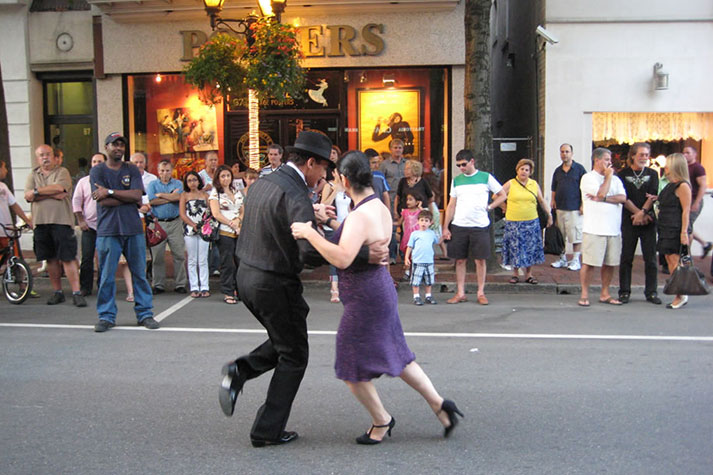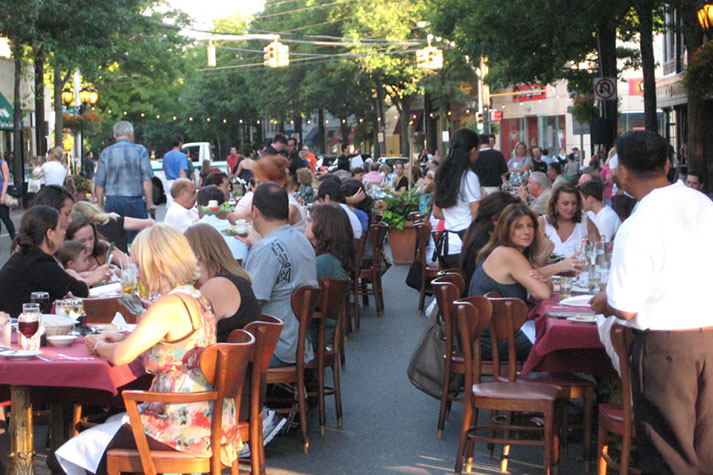Long Island is home to a variety of downtowns — more than 110 — from major employment centers and transit hubs to cultural destinations and quaint waterfront villages. Those that have become popular destinations offer many reasons to visit, from great dining, shopping, and people-watching to arts, culture, and recreation. When the Long Island Index asked residents which were their favorite downtowns, not surprisingly, the answers focused on those that had the greatest variety of things to do, including Huntington, Port Jefferson, Sayville, Babylon, Rockville Centre, and Garden City.
Other downtowns have been hurt by competition from malls or the economic recession, and have struggled to redefine themselves as relevant and vibrant. In fact, so many of the downtowns are seen as wanting that when the Index asked Long Islanders to nominate their favorite downtown, the largest percentage selected a shopping mall instead!
Clearly we have work to do. And that work is happening. Today, many downtowns are undergoing a revitalization effort to reinvigorate the community. There is no one-size-fits-all solution for creating a downtown that attracts local residents and visitors, but in analyzing those that do succeed, they all have some combination of the following characteristics:
Physical Characteristics
- Pedestrian-friendly environment
- Clean, well-maintained streets and sidewalks
- Incorporation of trees, shrubs, flowers, and planters, especially between sidewalks and streets
- Traffic calming features that force drivers to slow down through the downtown center
- Availability of public restroom facilities
- Street furniture, such as benches, lighting, and garbage cans
- Good lighting
- Directional signage (where can I park, where is the town/village/city hall, etc.)
- Easy access to adequate parking facilities, frequent and reliable public transportation, bike paths/bike racks
- Open space: public green space, shoreline
- Preservation of historic character, including historic sites and reuse of existing historic buildings
- Maintenance of a consistent scale for buildings/streetscape
- Outdoor cafes, ice cream parlors, and other businesses that draw patrons outside, increase pedestrian traffic, and create a highly visible gathering place
- Attractive storefronts that encourage window-shopping
Business
- Continuous line of storefronts closely clustered together, with few gaps between the buildings and roughly in line with each other
- Variety of businesses, including:
- Retail and non-retail stores and services
- Unique, one-of-a-kind or “Mom and Pop” shops
- Basic necessities such as food stores and drug stores
- Quality restaurants
- Low commercial vacancy rates
Organizations that Conserve/Grow the Community
- Business Improvement Districts (BIDs), community groups, and municipal agencies that focus on development of the downtown; Chamber of Commerce or other business development organizations
- Design review boards, landmark commissions, historical societies (organizations working to preserve historical elements of the community)
- Conservation and environmental groups
Resources
- Availability of a community center that provides diverse services and acts as a gathering place (e.g., library, town hall, community theatre)
- Availability of cultural venues in addition to movie theaters (e.g., concert halls, museums, and art galleries)
- Regular series of ongoing outdoor festivals and community celebrations, including a progression of events throughout the year
- Community bulletin boards and other centralized information sources and publications; directional signage
Other
- Good police support and a feeling of safety throughout the downtown, with good lighting, directional signage, and activities drawing people
- Inclusion of a range of housing choices in the downtown area, such as higher density housing, affordable housing, artists’ lofts, etc.
- Inclusion of new store owners, especially minorities and new immigrants, in the business community
Panning for Gold
So how does a community begin to reimagine its downtown? Where might it have room to grow? In 2010, the Long Island Index looked at downtowns in Nassau and Suffolk Counties to determine how much land is available for new development. Astoundingly, there are almost 13 square miles of land within walking distance of Long Island’s downtowns and train stations that could be used for new development — the equivalent of almost 7,600 football fields.
The yellow on the Long Island Index Interactive Maps downtown map shows acres of unbuilt land in Long Island’s downtown areas. The yellow parcels show land that could be converted to new housing, stores, businesses, cultural venues, civic spaces, and more. This is where our region’s greatest potential lies — our “gold.”
So what’s on most of those parcels today? Half of them are surface parking lots. Another quarter is vacant land and the balance is unprotected open space.
If we used just half that land for new development, we would have the potential to create 90,000 new housing units in the region.
However, if we opt to instead build 90,000 units of medium and large-lot single-family homes, similar to what we have today, we would consume all of Long Island’s remaining open space not currently protected for land preservation. All of it. That’s a stark contrast. Consume all of the remaining land on the Island by ‘building as usual’ or use half the 8,300 acres in the downtowns — half of one percent of all the land area in Nassau and Suffolk Counties — to create 90,000 new residences. The choice is clear.
Housing in the downtowns would be more affordable and more desirable to young adults who, in study after study, express an interest in more walkable communities. It would help foster economic growth and create more jobs in our economy. And it would breathe new life into Long Island’s downtowns.
Making these types of projects happen takes vision, leadership, and community support. Here is what four Long Island leaders say about transformation in their downtowns: http://vimeo.com/9001486.
Long Island’s Best Bets
Not every downtown has the same potential for growth. Here are our best bets on those downtowns that have the most available space, the busiest train stations, and the greatest mix of ingredients that can be cultivated to create a more vibrant community.
The table below indicates which Long Island downtowns have high potential for redevelopment:

The following downtowns have moderate potential to grow:

Downtowns not included within the two tables may also provide opportunities for new development. While some village centers are already vibrant and built-out, under the right circumstances, many more downtowns can be revitalized.



BE PART OF THE CONVERSATION
Follow @betterburb